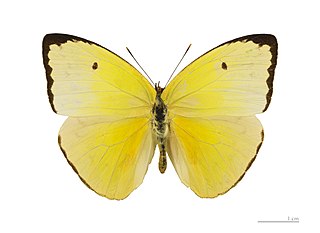
Phoebis sennae, the cloudless sulphur, is a mid-sized butterfly in the family Pieridae found in the Americas. There are several similar species such as the yellow angled-sulphur, which has angled wings, statira sulphur, and other sulphurs, which are much smaller. The species name comes from the genus Senna to which many of the larval host plants belong.

The Zabulon skipper is a North American butterfly first described by the French naturalists Jean Baptiste Boisduval and John Eatton Le Conte from the state of Georgia, United States.

Gonepteryx cleopatra, the Cleopatra or Cleopatra butterfly, is a medium-sized butterfly of the family Pieridae.

Nathalis iole, the dainty sulphur or dwarf yellow, is a North American butterfly in the family Pieridae.

Callophrys gryneus, the juniper hairstreak or olive hairstreak, is a butterfly native to North America. It belongs in the family Lycaenidae.

Euptoieta claudia, the variegated fritillary, is a North and South American butterfly in the family Nymphalidae. Even though the variegated fritillary has some very different characteristics from the Speyeria fritillaries, it is still closely related to them. Some of the differences are: variegated fritillaries have two or three broods per year vs. one per year in Speyeria; they are nomadic vs. sedentary; and they use a wide range of host plants vs. just violets. And because of their use of passionflowers as a host plant, variegated fritillaries also have taxonomic links to the heliconians. Their flight is low and swift, but even when resting or nectaring, this species is extremely difficult to approach, and, because of this, its genus name was taken from the Greek word euptoietos meaning "easily scared".

Euptoieta hegesia, the Mexican fritillary, is a North and South American butterfly in the family Nymphalidae.

Telegonus cellus, the golden banded-skipper, is a North and Central American species of butterfly in the family Hesperiidae. There are two populations, one in the eastern United States and the other in the southwestern United States and Mexico. The eastern population is rare and local and uses only one host plant, the thicket bean. The southwestern population is uncommon to common and uses more than one host plant. The golden banded-skipper is most active mid-morning and late afternoon. Their flight is sluggish and low to the ground, compared to closely related species.

Ancyloxypha numitor, the least skipper, is a North American butterfly in the family Hesperiidae. They have a weak, Satyrinae-like flight.

Danaus eresimus, the soldier or tropical queen, is a North American, Caribbean, and South American butterfly in the family Nymphalidae.

Eurema mexicana, the Mexican yellow, sometimes called the wolf-face sulphur, is a North and South American butterfly in the family Pieridae. It occurs mainly in Mexico but occasionally is found in central and southwestern United States and rarely in Canada.

Eurema proterpia, the tailed orange, is a North and South American butterfly in the family Pieridae.

Chlosyne lacinia, the bordered patch or sunflower patch, is a North and South American butterfly in the family Nymphalidae.

Callophrys henrici, the Henry's elfin or woodland elfin, is a North American butterfly in the family Lycaenidae. In Canada it is found from southern Manitoba to southern Nova Scotia. It has two main groups of populations in the United States; the first is found along the Atlantic Coast and uses various hollies (Ilex) as host plants; and the second is found mainly in the north and the Appalachians where they use redbud as a host plant. Henry's elfin is increasing in New England because of an introduced buckthorn it now uses as a host plant. It is listed as a species of special concern in the US state of Connecticut.

Papilio palamedes, the Palamedes swallowtail or laurel swallowtail, is a North American butterfly in the family Papilionidae.

Aphrissa statira, the statira sulphur, is a species of Lepidoptera in the family Pieridae. The species is a medium-sized yellow butterfly, with females more pale than males. They are found from southern regions of Florida and Texas through southern Brazil and northern Argentina. The caterpillars feed on the leaves of several local host plants, while adults prefer to feed on the nectar of red or orange colored flowers. The species is most noted for their dramatic migrations in the tropical areas of the Americas. They have been the subject of many studies about how butterflies navigate and orient during migration.

Chlorostrymon simaethis, the silver-banded hairstreak, is a North and South American butterfly in the family Lycaenidae. It is also known as St. Christopher's hairstreak and the Key lime hairstreak.

Papilio androgeus, the Androgeus swallowtail, queen page, or queen swallowtail, is a Neotropical butterfly of the family Papilionidae. It is found from Mexico to Argentina with a small population in southern Florida.

Oeneis nevadensis is a species of butterfly in the family Nymphalidae. It is commonly known as the great Arctic, Nevada Arctic, great grayling, Felder's Arctic, or Pacific Arctic. It is native to northwestern North America.

Phoebis argante, the apricot sulphur or Argante giant sulphur, is a butterfly in the family Pieridae.





















